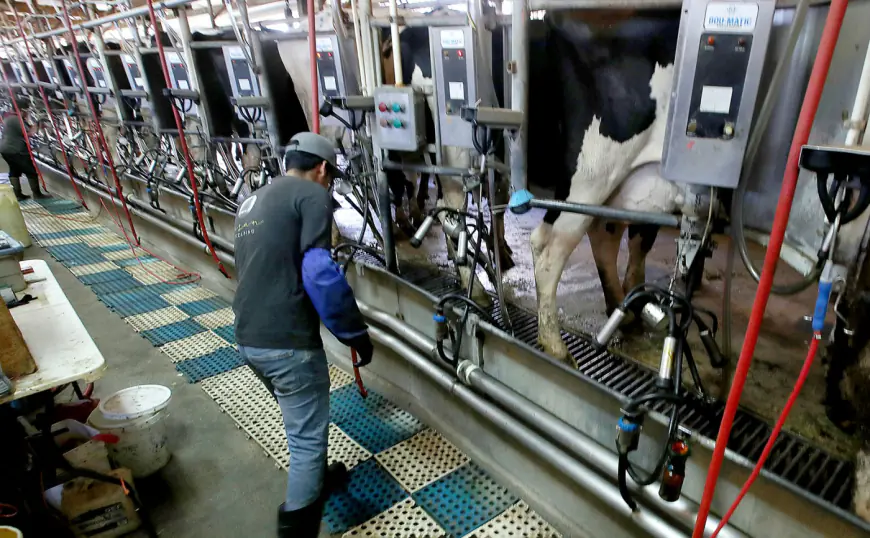Asymptomatic people may carry avian flu
As avian flu spreads in California dairies, new CDC study finds evidence of prior infection in people who felt healthy.

New research has revealed that even asymptomatic people carry the avian flu virus, suggesting that infections among dairy workers may be more common that presumed — and underscoring the need for better workplace protection.
In a study released by the U.S. Centers for Disease Control on Thursday, eight of 115 dairy farm workers, or 7%, who were exposed to H5N1 bird flu during outbreaks among dairy cows at farms in Michigan and Colorado had antibodies to the virus, showing evidence of infection.
While four workers remembered having symptoms, mostly conjunctivitis, the other four workers did not recall being sick. All eight people reported milking cows or cleaning a milking parlor
In response, the CDC is expanding its recommendation for testing, saying that the test should be offered to any worker who has been exposed to the virus but lacks symptoms. It also encouraged broader use of the antiviral drug Tamiflu for all exposed workers. Finally, it urged better use of protective tools, like face masks.
Scientists worry that the virus may develop mutations as it spreads, making it more dangerous or skilled at jumping from person to person. So far, all infections were acquired through direct contact with infected animals or milk.
“The less room we give this virus to run, the fewer chances it has to cause harm or to change,” said Dr. Nirav Shah, CDC’s principal deputy director, in a Thursday morning press briefing. “The best way to limit the virus’s room to run is to test, identify, treat and isolate as many cases as possible in humans and as quickly as possible.”
It is not yet known how often workers may be unknowingly infected, said Shah, adding that research is underway to better understand “how much of the iceberg is above the water, versus below the water.”
To date, there have been 46 human cases of avian flu in the U.S. Of these, 21 live in California. All live and work in the San Joaquin Valley and had exposure to infected cows.
The bird flu is ravaging dairy herds in the San Joaquin Valley, with milk output down noticeably, reported Sarina Sharp, a dairy analyst based in Michigan, in her most recent weekly report for the Milk Producers Council.
While the virus has hampered herd health and milk production in other states, the impact in California has been especially devastating, according to Sharp.
“By most accounts, milk production has fallen harder and cows have suffered more than infected cows elsewhere,” she wrote.
That may be because avian influenza is infecting California cows that have already struggled through a very hot summer. Or perhaps California cattle are infected with a particularly virulent strain.
California is the nation’s top dairy state, contributing about 16% of U.S. milk output. So far, the nation’s milk prices are not yet affected.
Milk from sick cows is not permitted in the public milk supply. Also, pasteurization of milk is fully effective at inactivating the virus, so there is no cause for concern for consumers of milk or dairy products.
The affected dairies have been placed under quarantine on the authority of California’s state veterinarian, and enhanced biosecurity measures are in place. Sick cows are isolated and are being treated at the dairies; and healthy cows have been cleared to continue shipping milk for pasteurization.
According to Anja Raudabaugh, CEO of Western United Dairies, the virus was introduced by cows purchased from an out-of-state dairy and then moved to California before they showed clinical signs.
Though the virus remains deadly to poultry, most dairy cows fully recover within a few weeks. Infected cows typically experience a drop in milk production during the illness.
The new study is important because it reveals the possibility of infection despite the absence of symptoms, as well as highlighting the need for better tools to protect workers, said Dr. Demetre Daskalakis, CDC’s director of the National Center for Immunization and Respiratory Diseases.
In the study, none of the workers wore respiratory protection, and less than half wore eye protection, highlighting the need for better tools to support worker protection.
According to the California Department of Public Health, the risk to most people is low. People working with infected animals are at greater risk of becoming infected. No person-to-person spread of bird flu has been found. And no one has died due to bird flu.
But its spread is worrisome because avian flu can be serious, says the California Department of Public Health. We don’t yet know if there are any long-term symptoms or effects from this virus. A bird flu vaccine for people and cattle is not yet available.
What's Your Reaction?









































































































